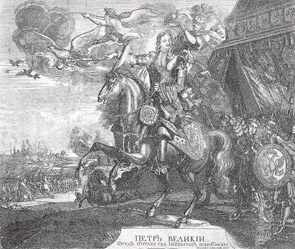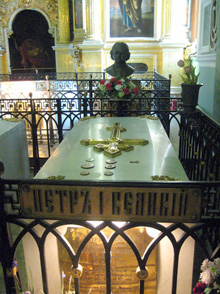|
 Peter I Romanov (1672 - 1725) was the czar of Russia (1682 - 1725) and Russian Emperor (1721 - 1725).
Peter I Romanov (1672 - 1725) was the czar of Russia (1682 - 1725) and Russian Emperor (1721 - 1725).
Peter was a son of
Tsar Alexei Mikhailovich Romanov
(19.03.1629-29-01.1676) and
Czarina Nathalie Kirillovna Naryshkina.
As a result of long and bloody struggle for power between
the Naryshkin and Miloslavsky factions Peter had
become sole czar in 1696.
One of his first independent ventures was
the seizure of the fortress of Azov in summer 1696 and
then the founding
of the town of Taganrog. Peter I initiated the creation
of the Russian fleet. After the victorious completion
of Azov campaign Tzar Peter began to
study European shipbuilding. As a member of
Grand Embassy (traveling incognito as the
captain Peter Mikhailov) he visited Holland, Austria,
Saxony and Poland. He studied military science,
shipbuilding, mechanics and papermaking. The
young Tzar understood that to become a modern
European country Russia needed an outlet to the Baltic Sea.
After entering into an alliance with Denmark and Saxony and making peace with the Ottoman Empire he declared
war on Sweden in 1700. It was in this way the twenty-one-year Great Northern war began. The aim of the war was to regain Russian land on the
Baltic captured by Sweden in XVI century.
 First major defeat of Russians at Narva in 1700 forced Russian Tzar Peter to start sweeping army reform and
armament replacement. Troops were armed with flint-lock muskets with bayonets, field and naval artillery were armed with new guns of standard
types and calibers. Taxation system reform introduced by Russian the Tzar played a large role in army reorganization. As a diplomat Peter
I took under control all foreign-policy activity of Russia. He introduced for the first time diplomatic representatives and consulates abroad and
abolished outdated forms of diplomatic etiquette.
First major defeat of Russians at Narva in 1700 forced Russian Tzar Peter to start sweeping army reform and
armament replacement. Troops were armed with flint-lock muskets with bayonets, field and naval artillery were armed with new guns of standard
types and calibers. Taxation system reform introduced by Russian the Tzar played a large role in army reorganization. As a diplomat Peter
I took under control all foreign-policy activity of Russia. He introduced for the first time diplomatic representatives and consulates abroad and
abolished outdated forms of diplomatic etiquette.
During the Great Northern war a new state control system based on collegiums subordinated to the Senate was
created. The Russian Tzar introduced a new administrative division system based on government. Substantial changes also took place in the
religious system; to separate the church from, and subordinate it to the state, Peter I replaced the patriarchate with the Holy Synod based on
the collegiate principle and overseen by the Over-Procurator. He instituted the Academy of Sciences, established the country's first newspaper
"Vedomosti" and laid the foundation for book-printing. The Tzar promoted development of metal, mineral resource and textile industries that
turned Russia into a peer partner on European market.
During the Great Northern war Peter I became an experienced military leader. He advanced an idea of all weapons
 of war mobilization to achieve a decisive superiority over the enemy as well as their flexible use as a situation required. The victory gained by
Russians in the battle of Poltava finally lead to the signing of the favorable Treaty of Nystad in 1721. According to this treaty Russia acquired
former Swedish possessions on Baltic and soon turned them from a semi-feudal state into a powerful European empire. Due to efforts of the
Russian Tzar a new capital of the country - St. Petersburg, was founded in 1703. This town was built by the best European architects. Regarding
Ukraine Peter I carried out a strict policy of centralization that as a result lead to destruction the Cossack community of Ukraine (Zaporozska Sich)
and later to the renaming of Ukraine Small Russia (Malorossia).
of war mobilization to achieve a decisive superiority over the enemy as well as their flexible use as a situation required. The victory gained by
Russians in the battle of Poltava finally lead to the signing of the favorable Treaty of Nystad in 1721. According to this treaty Russia acquired
former Swedish possessions on Baltic and soon turned them from a semi-feudal state into a powerful European empire. Due to efforts of the
Russian Tzar a new capital of the country - St. Petersburg, was founded in 1703. This town was built by the best European architects. Regarding
Ukraine Peter I carried out a strict policy of centralization that as a result lead to destruction the Cossack community of Ukraine (Zaporozska Sich)
and later to the renaming of Ukraine Small Russia (Malorossia).
In 1721, the Senate proclaimed him
"Emperor of all Russia." In 1724 his second wife
was coronated as
Empress Catherine I
(1725 - 1727). Peter I died on Jan. 28, 1725 having reigned
forty-two years. He was buried in
St. Peter and Paul cathedral
in St. Petersburg.
|
 History
History
 Dates and events
Dates and events
 Persons
Persons
 Poltava
Poltava
 Sights
Sights
 Photo gallery
Photo gallery
 Maps
Maps
 Virtual Museum
Virtual Museum
 Armament
Armament
 Uniforms
Uniforms
 Coins and medals
Coins and medals
 Flags
Flags
 Paintings
Paintings
 Poltava photographs
Poltava photographs
 News
News
 About us
About us
 Acknowledgments
Acknowledgments
 Main page
Main page
 top
top ...back
...back  History
History
 Dates and events
Dates and events
 Persons
Persons
 Poltava
Poltava
 Sights
Sights
 Photo gallery
Photo gallery
 Maps
Maps
 Virtual Museum
Virtual Museum
 Armament
Armament
 Uniforms
Uniforms
 Coins and medals
Coins and medals
 Flags
Flags
 Paintings
Paintings
 Poltava photographs
Poltava photographs
 News
News
 About us
About us
 Acknowledgments
Acknowledgments
 Main page
Main page